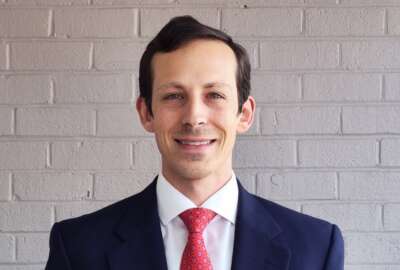
Sammies finalist investigates helicopter crashes to improve flight safety
Often the most mundane-sounding mistakes can cause catastrophe, like the time a passenger seatbelt caught a knob on the floor of a helicopter.
Best listening experience is on Chrome, Firefox or Safari. Subscribe to Federal Drive’s daily audio interviews on Apple Podcasts or PodcastOne.
Often the most mundane-sounding mistakes can cause catastrophe, like the time a passenger seatbelt caught a knob on the floor of a helicopter. It crashed into the East River in New York and killed five people. Chihoon Shin has investigated this and many other helicopter crashes, thereby improving safety. He’s now a finalist in this year’s Service to America Medals program. Shin is an investigator with the National Transportation Safety Board, and joined Federal Drive with Tom Temin for more information.
Interview transcript:
Tom Temin: Mr. Shin, good to have you on.
Chihoon Shin: Good morning.
Tom Temin: And you are kind of a specialist within the NTSB on helicopter crashes, an unfortunate kind of thing I guess have to spend your life on, but tell us how you came to this particular expertise?
Chihoon Shin: Sure. So out of college, I was actually hired by the US Navy and worked at a Naval Air Systems Command down in Cherry Point, North Carolina. That’s where I got my introduction to accident investigation and actually also the world of helicopters. So every now and then when the Navy had a mishap as they call them, involving warmed the helicopters, I was specialized with the H-60 Seahawk platform as a transmission and drive system engineer. The engineering side we would get involved in terms of assisting the mishap board and the naval Safety Center and identifying issues that might be related to our particular systems of interest. So that’s what really sparked my interest in accident investigations. And once an opportunity came up at the National Transportation Safety Board for a helicopter engineer, and the Office of Aviation Safety, I jumped on that opportunity and I’m glad and happy that they hired me. This is a very interesting work to do as a full time job.
Tom Temin: So you are also a professional engineer in helicopter specialty?
Chihoon Shin: So in my past, yes, I worked with helicopter transmission systems for about five and a half years supporting the US Navy, in service we have H-60 helicopters.
Tom Temin: Got it. And often you know when these highly publicized crashes occur like the one in the East River, and they do happen occasionally, or the Grand Canyon one of these helicopters, people seem to jump to the idea immediately that the thing fell to pieces. The fact is, these are so highly engineered now. It’s almost always something lower level than the catastrophic failure the newscasters like to talk about on television.
Chihoon Shin: Yeah, usually with accidents, it’s usually multiple factors that come together that caused the accident. It’s very rare that it’s just one single thing that we’ll pin it down on. Usually multiple errors combine to cause an accident. How we like to describe this is kind of like the Swiss cheese model where you have to have the holes line up and the accident, essentially those circumstances all line up, and the air goes through all those holes and causes the accident
Tom Temin: Because in the accident described in your Service to America Medal citation, something ridiculous sounding almost like a fuel cutoff valve that is in the floor of the passenger compartment. I mean, how is it, In your opinion I guess, or how do you feel when a manufacturer will spend billions of dollars developing an engine that can run at 1000 degrees for 10 hours and never fail in the lifetime of the thing, but then they put a knob that should never be touched by anyone right there in the passenger compartment.
Chihoon Shin: First, things like that we look at all the different factors, the history of this design, how many times in the past that it’s been tripped unintentionally, or intentionally by a pilot or someone that was sitting near the controls. We’ll also look at the operational side, is there a higher risk of putting a passenger next to those controls or not. And in then that accident investigation we identified many different factors that basically combined to cause this accident to occur. In this case with this fuel cut off lever right next to the passenger. It wasn’t the first flight that they tried this that it happened. This operator had been flying many of these flights and it just happened to be in that unfortunate day the confluence of many different factors that came about that caused that accident. So in our investigations, we’ll identify a number of factors that add up to cause the accident and also achieve or attempt to achieve safety changes and all those factors to try to prevent future accidents from happening.
Tom Temin: And how do the manufacturers react when, like for example in that switch on the floor, I have a rack full of equipment in my studio and the one piece that is the power supply has a cage screwed over it so that you can’t accidentally hit the power switch and blow everything. Something basic like that, you would think that would be on the floor of the helicopter a little cage over something so it would take a sledgehammer to move it. And do manufacturers scratch their head and say, yeah Shin you’re right, or hey we know what we’re doing.
Chihoon Shin: It depends, again, when we look at the design in our investigation. In this particular case, Airbus Helicopters, they looked at this design saw that it flew for almost, I believe, 30 million flight hours and only had a couple of instances where actually I should say the adjacent control next to it had a couple of instances of interference, and so they ended up redesigning that. This particular fuel cut off lever, there’s only been one reported instance, which is this accident. So they look at the past service history of it, weigh it against how it’s being protected, how it’s being used. In this particular case, they agreed with us that it could be redesigned to be more robust in terms of preventing inadvertent activation from either the pilot or the passenger. So a lot of different investigations depending on the factors that we identify that caused that accident or to cause the event control to be misutilized or the different wrong press or whatnot,. We’ll analyze those factors with the manufacturer. Most of the times we come to the same opinion, sometimes we different opinions, and when we do, the NTSB can issue recommendations and essentially use our bully pulpit to try to sway the manufacturer to take the right action. Or even for the FAA, the Federal Aviation Administration, to force a manufacturer to take safety actions.
Tom Temin: And how do you keep your own equilibrium when you know the work involves seeing horrible situations? In the case of the East River, it probably was a simpler investigation in the sense that everything was intact. It didn’t blow up and burn it just fell into the water and sank. Sometimes you must go to a site where often there’s fire and terrible destruction, including of the human beings inside, then you’re the first on the scene.
Chihoon Shin: Yeah, so in those cases where we do lose a lot of evidence from the post crash fire or from fragmentation of the helicopter when it goes through trees or whatnot, it does make for a much more difficult investigation from my perspective as being a helicopter engineer trying to look at the wreckage. That’s where the NTSB has advocated for recorders, crash resistant-crash protective recorders to be installed on helicopters. The NTSB actually just issued recommendations to manufacturers last month for manufacturers to voluntarily equip their helicopters with crash resitant recorders because that data is so key and understanding the final moments leading up to the accident and what the pilot control inputs were, what the displays were showing, what the helicopter itself was doing, just because the helicopter is a very dynamic machine. We do lose a lot of that data when we don’t have recorders or black boxes on board. And so, in those cases, we look at the wreckage. One thing that a metallurgist once told me when I was working with the Navy was the metal doesn’t lie. It’s a lot harder job with composites nowadays, but with metals, we look at how it’s crushed, how it’s fractured, look for things that look abnormal or unique and start trying to piece together what happened with a helicopter. Was it functioning normally, was it not prior to impact.
Tom Temin: How do you deal with the human remains that might be there if you’re the first on the scene?
Chihoon Shin: So luckily, the majority of the times, especially with helicopters being smaller, usually the first responders that get there, the firefighters, paramedic, local law enforcement, will identify those remains and those will actually be removed from the helicopter from the wreckage prior to us getting there. From time to time we do run across human remains at times, and that’s when we coordinate with the coroner, the local medical officer to remove those pieces and it’s a unfortunate side of the job but it also reminds us there is a human aspect to these accidents, these are tragedies that happen and our work is very important and identifying these factors so that we don’t have these tragedies repeat themselves that end up in more suffering.
Tom Temin: Now I’m a 2 million mile airliner flyer, helicopters scare the heck out of me. There’s something about them that seems like all they want to do basically is they’re always on the verge of going out of control and crashing. Doing what you have done all these years, do you fly on helicopters, and would you let your family on them?
Chihoon Shin: I do still fly on helicopters. Helicopters are unique compared to fixed wing airplanes in that they they beat the air into submission, right. But at the end of the day, they perform tasks that are so unique, that are so useful, that airplanes just can’t. Rescuing someone from a cruise ship with the Coast Guard using their helicopters, firefighting, there’s just a lot of utility to them that make them so important integral to our aviation industry, and our society in general. One quote that I love with with helicopters with respect to their utility is, and I’m probably going to get this wrong because I’m doing this from memory but, “to fly is heavenly to hover as divine.” That’s what helicopters do, they hover and it’s an amazing feeling when you hover.
Tom Temin: Chihoon Shin as an investigator with the National Transportation Safety Board and a finalist in this year’s Service to America Medals. Thanks so much for joining me.
Chihoon Shin: Thank you very much.
Find out more about Chihoon’s work here.
Copyright © 2024 Federal News Network. All rights reserved. This website is not intended for users located within the European Economic Area.
Tom Temin is host of the Federal Drive and has been providing insight on federal technology and management issues for more than 30 years.
Follow @tteminWFED





